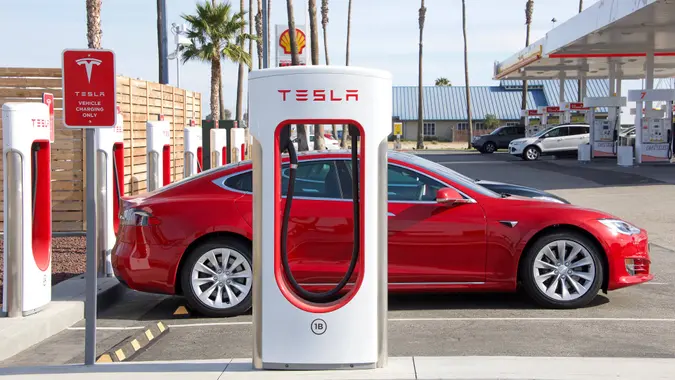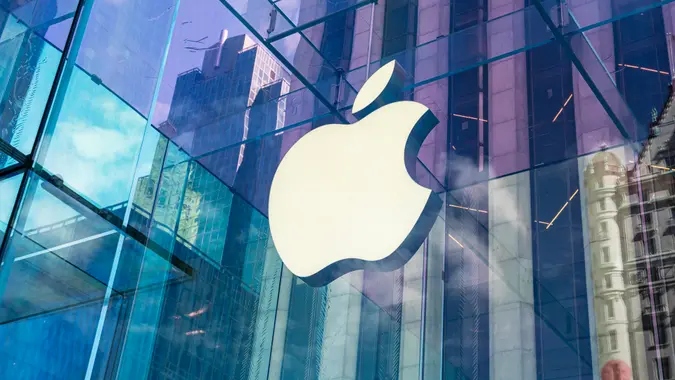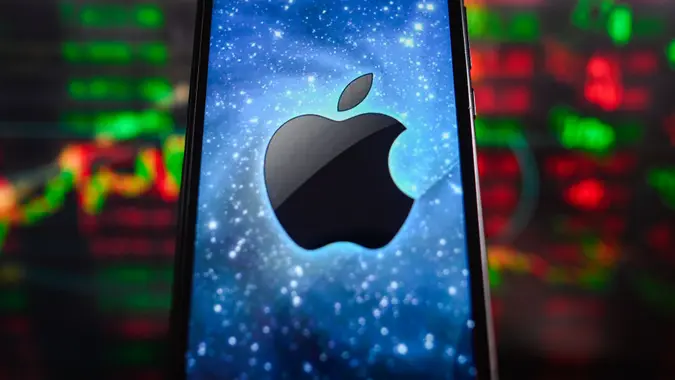IPO Explained: What Is an Initial Public Offering?

Commitment to Our Readers
GOBankingRates' editorial team is committed to bringing you unbiased reviews and information. We use data-driven methodologies to evaluate financial products and services - our reviews and ratings are not influenced by advertisers. You can read more about our editorial guidelines and our products and services review methodology.

20 Years
Helping You Live Richer

Reviewed
by Experts

Trusted by
Millions of Readers
When a private company decides to sell stock to the public, it holds an initial public offering or IPO. This marks the first time investors can buy shares, offering potential opportunities — but also risks.
Companies go public to raise capital, expand or build brand recognition. While IPOs can offer growth potential, early trading can be volatile, requiring investor patience. Read on to learn more.
What Is an IPO?
When a company first starts, it is typically owned by a few people. Usually, companies are either a single proprietorship, a partnership or a corporation. As a private company grows, the ownership may decide to go public.
It is helpful to understand what it means for a company to become an IPO and why a decision is made to go public.
IPO Definition
An IPO stands for initial public offering. This essentially means a private company has gone public. It is the first time others can purchase company shares in the stock market. The company now has shareholders.
Why Companies Go Public
There are various reasons a private company may choose to go public. Sometimes companies want to develop new products, or they may want to expand geographically and need additional capital to do so.
Other reasons may include the following:
- To allow owners and employees to sell their stock more easily.
- To increase the company’s public image or brand awareness.
- To acquire other businesses in exchange for stock in the company.
- To provide stock or stock options to current or potential employees as a benefit.
- To raise capital and increase the opportunity for access to capital in the future.
Good To Know
A decision to go public signals that a company is mature and stable enough to move forward with a larger, more lucrative vision for the future.
This kind of confidence may fuel other investors to want to participate in the growth of the company.
Going public can increase brand recognition and market enthusiasm for the company.
How Does the IPO Process Work?
The IPO process involves several steps. There are behind-the-scenes actions that need to occur before the first public offering takes place. Here’s a look at three phases of the offering: preparation, pricing and launching of the IPO.
Preparing for an IPO
It takes multiple steps to prepare a private company to become an IPO. Those steps include the following:
Underwriting
- Underwriters propose that when a company decides the time is right to “go public,” the company’s management consults with investment banks who will underwrite the deal.
- These banks, having been through lots of IPOs before, will give management an idea of how much they think shares of the company will bring to the open market.
- They’ll also weigh in on the timing of the IPO since market sentiment can often impact an IPO’s success.
Filing
- Next, a banking syndicate is formed. This group of institutions will share the costs to bring the IPO to market and will submit the necessary paperwork to financial regulators.
- Their first step is to draft an S-1 registration statement, which discloses pertinent information about the company.
- Potential investors will use this statement to make an informed decision about whether to invest and at what price.
Pricing the IPO
Market demand and the company’s valuation influence an IPO’s share price.
Just like an insurance underwriter, an investment underwriter determines how much risk investors are likely to see in the company, and then they price that risk. After some back-and-forth negotiation, this process results in the offering price for the IPO, which is the price at which the stock will first be offered for sale.
The date for the offering is set. The opening price can change if conditions also change, up until the day before the offering. On that day, about 90% of the shares are allocated to institutional investors, leaving only about 10% for everybody else.
Launching the IPO
Once the day of the IPO arrives, the shares are offered for trading at the price that was agreed upon by the company and the syndicate.
When the stock market opens and the bell rings, the market takes over, and shares will trade at the price investors are willing to pay for them. This can be considerably lower or higher than the IPO price, making IPO investing one of the riskiest kinds of investing.
Pros and Cons of IPOs for Companies
A private company going public is a big decision and has its advantages and disadvantages. If a company goes public, success is not guaranteed. It is important for a company to balance the pros and cons.
Benefits of Going Public
- Access to more capital. Companies that go public are able to access capital from the entire investing public.
- Better visibility. Public companies can increase credibility and brand recognition, which could fuel goodwill from investors and the public.
- Ability to attract more skilled workers. With stock compensation options, top talent may be incentivized to apply for positions in the company.
- Lower cost of borrowing. A public company may receive more favorable loan terms.
Challenges of Going Public
- Loss of control. Key investors will have more say in the company’s decision-making. Control is not designated to one or two people as it may have been in a private company.
- Stock volatility. Stock prices can go up and down based on market volatility. This may lead to a lack of stability in the company.
- Significant costs. There are substantially more legal, accounting and marketing costs involved in a public company.
- Regulatory compliance. Public companies are regulated by the SEC and have to disclose financial details. These tasks can take time, effort and money for a new IPO.
- Meeting shareholder expectations. A company has to meet shareholder’s expectations, which may mean jockeying for short-term profits.
Famous IPOs in History
You may have heard of famous IPOs. Companies like Facebook, Alibaba and Tesla were once private, but successfully became notable IPOs.
Notable Examples
- Tesla. Tesla went public in 2010 and proved to be a game-changer in the electric vehicle industry. The initial offering was 13,300,000 at a price of $17 a share.
- Facebook. One of the largest tech IPOs, Facebook, went public in 2012. The initial price offering was $38 per share. It had a slow start, but is now one of the most profitable companies in the world.
- Alibaba. A record-breaking IPO at the time, Alibaba, was one of the largest IPOs at the time in 2014. Alibaba launched an e-commerce and cloud computing company in China.
There are a few key lessons to learn from successful IPOs. These IPOs tend to be disrupters of their respective industry. In addition, these IPOs focus and pay attention to consumer demand. Successful IPOs also capture market trends and have a clear vision of innovation.
Final Take
Investing in IPOs is not for the faint of heart, nor is it for the novice investor. Since there’s no real way to know the true value of a newly public company, i.e., the price other investors are willing to pay for a share of its stock, you won’t know until the stock starts trading whether you’ve made the right decision or not.
However, if you’re an experienced investor with significant holdings — plus the connections to get in on IPO offerings before they hit the market — you may be able to make good money from these newly public companies.
FAQ
Here are the answers to some of the most frequently asked questions about IPOs.- What does IPO stand for?
- IPO stands for initial public offering.
- Why do companies go public through an IPO?
- Companies may go public for the following reasons:
- To raise more capital for expansion.
- Create brand recognition.
- Allow early investors and employees to cash out their holdings.
- Companies may go public for the following reasons:
- How does the IPO process work?
- The IPO has several steps.
- First, you pick the underwriters to manage the IPO. The underwriters file the S-1 registration statement.
- The next steps are marketing and setting the price for the IPO.
- Once those steps are complete, the IPO is launched and is available to the public.
- The IPO has several steps.
- What are the risks of investing in IPOs?
- Stocks can be volatile in early trading, companies may be overvalued, and there is limited historical data.
- How can I evaluate whether to invest in an IPO?
- Investing in an IPO is risky, and you have to do your due diligence in researching the company. Study the prospectus, analyze key metrics, assess the team and consider the valuation of the company before investing in an IPO.
- What is the difference between an IPO and a direct listing?
- With an IPO, new shares are sold to investors, while a direct listing is selling existing shares. There are no underwriters with a direct listing, while an IPO's price is set by investment banks.
- Can retail investors participate in an IPO?
- Retail investors can invest, but access is limited. Institutional investors get investment access first.
Karen Doyle contributed to the reporting for this article.
Our in-house research team and on-site financial experts work together to create content that’s accurate, impartial, and up to date. We fact-check every single statistic, quote and fact using trusted primary resources to make sure the information we provide is correct. You can learn more about GOBankingRates’ processes and standards in our editorial policy.
- U.S. Securities and Exchange Commission. 2019. "Going Public."
- Business Insider. 2020. "What Is an IPO? the Process Explained and How."
- Fortune. 2020. "Wish IPO Is 2020's Worst Among Big Debuts."
- Tesla. 2010. "Tesla Announces Pricing of Initial Public Offering."
- The Week. 2015. "Facebook's first year as a public company: By the numbers."
- ICE. 2014. "Alibaba Group Celebrates Initial Public Offering and First Day of Trading on the New York Stock Exchange."
 Written by
Written by  Edited by
Edited by 

























